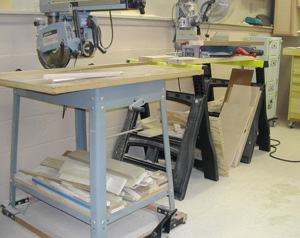
 by Steven D. Johnson
by Steven D. Johnson
Racine, Wisconsin
(Page 2 of 4)
Previous Page
1
2
3
4
Next Page
Parting With A Cherished Tool
Sweet, so would I,
yet I should kill thee with much cherishing.
Good night, good night! Parting is such sweet sorrow,
that I shall say good night till it be morrow.
Shakespeare's oft-quoted verse is apropos when contemplating the replacement of a power tool...the
departing machine will undoubtedly bring joy to its new owner. Smiles appear at the memories of all
the great work the tool and I did together. A tear appears, too, at the sorrow of parting with an
old and faithful friend.
For months now, I have anguished over the obvious redundancy of a very high quality miter saw and
an old, and hence, high quality radial arm saw (RAS) both residing in my shop.
Both saws make wonderful cuts. Both occupy roughly equal space (11.1 square feet for the RAS and
12.5 for the miter saw). Both have been "tweaked" with the best blades (Forrest Chopmaster), and have been lovingly calibrated. In a test, the miter saw can actually crosscut a
wider piece than the RAS, if that sort of thing is important, but for me that difference alone was
not enough to sway my decision.
Complicating my decision has been the fact these are very different saws that, at least for me,
do essentially the same thing. Keep in mind, this radial arm saw is no devolved, modern, cheap,
stamped-steel, foreign made, boardroom influenced, dumbed-down, safety-tricked, and highly
compromised-for-profit tool. This is a vintage Delta. Heavy iron, precise machining and close
tolerances have allowed no slop in any movement, even after years of hard work. There is no
electronic blade brake. When you turn off the motor, it glides to a stop over an agonizingly long,
but whisper quiet period of time...a testimony to the high quality motor and bearings they used way
back when.

|
|
|
The miter saw, on the other hand, is a highly evolved piece of innovative engineering...a long,
long way from the old chop saws that are now generally bequeathed to the rough framers for cutting
studs to length. Solid state soft start motor and electronic blade brake, articulated and rigid
arm, left- or right-handed use, ergonomics galore, this miter saw is a good example of advanced
engineering and state-of-the-art technology.
Different saws, both good, and both able to make (relatively) the same cuts...what to do?
In the past, when I was young and (more) foolish, I ripped lumber on the radial arm saw, a
dangerous proposition no matter how you slice it (pun intended). I have also cut dados, angles, and
even a bevel or two. But for the last several years the saw has been dedicated solely to cross cuts.
It is exactingly set, locked down, and nothing moves except when I raise the carriage to change or
clean the blade. It is a truly "one-cut-wonder." And it does make perfectly square cross cuts,
rarely requiring any clean up at the shooting board.
The miter saw, purchased last year to replace an older model, is much better than the one it
replaced. While it can be made to cut slightly less-than-perfect 90-degree cuts, it generally does
a pretty good job (it is all about technique, but that is a different story). It has the added
advantage of being able to quickly, and relatively accurately, cut other angles, be they 45-degrees,
22.5-degrees, or something in-between. It is fast, convenient, safe, and with the Forrest blade and
a little care, there is no blow out on the backside of cuts (something that, in my experience, is
common with most miter saws).
Sitting side-by-side in the shop, I have found myself lately going to the miter saw for almost
every cut. In fact, only when I needed to set up a stop and cut a number of pieces to the exact
same length did I turn to the RAS.
In the end, versatility, ease of use, and habituation have steered my decision to keep the miter
saw. I know there will be a chorus of readers that will tell me I am making a mistake getting rid
of my trusty RAS, and you are probably right. But space is at a premium and I simply have to
choose.
While I will continue to have second thoughts, I have to move on. Having made my decision, the
first order of business is to build a stand for the miter saw. From the day it was delivered, the
saw's home has been a pair of plastic sawhorses with a couple of 2 X 6's on top. In order for the
miter saw to achieve its fullest potential it needs a firm, purpose-made base. One rainy afternoon
I plowed through about ten year's worth of magazines and looked at every miter saw stand design...and
there have been a bunch. Some were quite nice. Some tried to be or do too many things. Some were
simply too cute by half. I decided to start with a clean piece of paper and a clear mind.
The design phase of any project, or what I refer to as "noodling out" a design, is a blast. I
start by making a list of design criteria...the "gotta have" features, which inevitably lead to more
questions and considerations, but serve as an indispensible guide.
(Page 2 of 4)
Previous Page
1
2
3
4
Next Page
Return to Wood News front page
